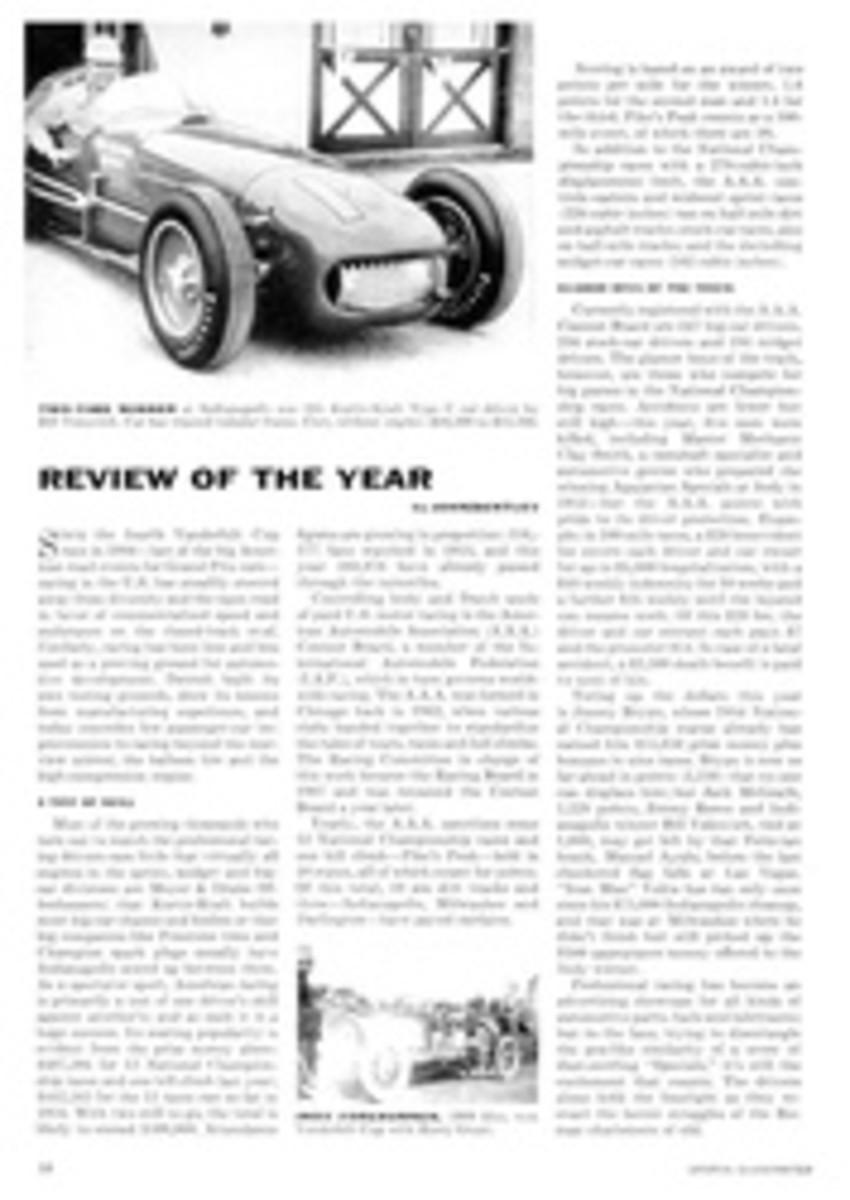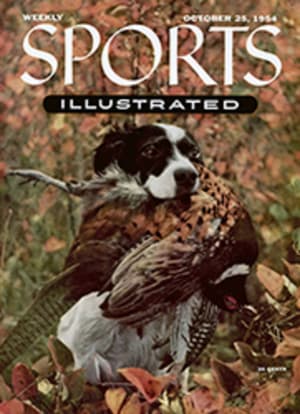
REVIEW OF THE YEAR
Since the fourth Vanderbilt Cup race in 1908—last of the big American road events for Grand Prix cars—racing in the U.S. has steadily steered away from diversity and the open road in favor of commercialized speed and endurance on the closed-track oval. Similarly, racing has been less and less used as a proving ground for automotive development. Detroit built its own testing grounds, drew its lessons from manufacturing experience, and today concedes few passenger-car improvements to racing beyond the rear-view mirror, the balloon tire and the high-compression engine.
A TEST OF SKILL
Most of the growing thousands who turn out to watch the professional racing drivers care little that virtually all engines in the sprint, midget and big-car divisions are Meyer & Drake Offenhausers; that Kurtis-Kraft builds most big-car chassis and bodies or that big companies like Firestone tires and Champion spark plugs usually have Indianapolis sewed up between them. As a spectator sport, American racing is primarily a test of one driver's skill against another's; and as such it is a huge success. Its soaring popularity is evident from the prize money alone: $407,294 for 12 National Championship races and one hill climb last year; $442,165 for the 11 races run-so far in 1954. With two still to go, the total is likely to exceed $500,000. Attendance figures are growing in proportion: 356,-277 fans watched in 1953, and this year 388,876 have already passed through the turnstiles.
Controlling body and Dutch uncle of paid U.S. motor racing is the American Automobile Association (A.A.A.) Contest Board, a member of the International Automobile Federation (I.A.F.), which in turn governs worldwide racing. The A.A.A. was formed in Chicago back in 1902, when various clubs banded together to standardize the rules of tours, races and hill climbs. The Racing Committee in charge of this work became the Racing Board in 1907 and was renamed the Contest Board a year later.
Yearly, the A.A.A. sanctions some 12 National Championship races and one hill climb—Pike's Peak—held in 10 states, all of which count for points. Of this total, 10 are dirt tracks and three—Indianapolis, Milwaukee and Darlington—have paved surfaces.
Scoring is based on an award of two points per mile for the winner, 1.6 points for the second man and 1.4 for the third. Pike's Peak counts as a 100-mile event, of which there are 10.
In addition to the National Championship races with a 270-cubic-inch displacement limit, the A.A.A. controls eastern and midwest sprint races (220 cubic inches) run on half-mile dirt and asphalt tracks; stock-car races, also on half-mile tracks; and the dwindling midget-car races (102 cubic inches).
GLAMOR BOYS OF THE TRACK
Currently registered with the A.A.A. Contest Board are 247 big-car drivers, 234 stock-car drivers and 194 midget drivers. The glamor boys of the track, however, are those who compete for big purses in the National Championship races. Accidents are fewer but still high—this year, five men were killed, including Master Mechanic Clay Smith, a camshaft specialist and automotive genius who prepared the winning Agajanian Specials at Indy in 1952—but the A.A.A. points with pride to its driver protection. Example: in 100-mile races, a $28 benevolent fee covers each driver and car owner for up to $5,000 hospitalization, with a $40 weekly indemnity for 10 weeks and a further $25 weekly until the injured can resume work. Of this $28 fee, the driver and car entrant each pays $7 and the promoter $14. In case of a fatal accident, a $2,500 death benefit is paid to next of kin.
Toting up the dollars this year is Jimmy Bryan, whose 1954 National Championship status already has earned him $55,650 prize money plus bonuses in nine races. Bryan is now so far ahead in points (2,230) that no one can displace him; but Jack McGrath, 1,220 points, Jimmy Reece and Indianapolis winner Bill Vukovich, tied at 1,000, may get left by that Peruvian bomb, Manuel Ayulo, before the last checkered flag falls at Las Vegas. "Iron Man" Vukie has run only once since his $75,000 Indianapolis cleanup, and that was at Milwaukee where he didn't finish but still picked up the $500 appearance money offered to the Indy winner.
Professional racing has become an advertising showcase for all kinds of automotive parts, fuels and lubricants; but to the fans, trying to disentangle the pea-like similarity of a score of dust-swirling "Specials," it's still the excitement that counts. The drivers alone hold the limelight as they re-enact the heroic struggles of the Roman charioteers of old.
TOP TEN RACES OF 1954
MAY 31: INDIANAPOLIS, IND.
500 miles; 2½ mile brick & asphalt; crowd 185,000 (est.). Total prize money $269,875. 33 started—11 finished 200 laps.
1. Bill Vukovich (Fuel Injection Spcl) 130.840 mph.
2. Jimmy Bryan (Dean Van Lines Spcl).
3. Jack McGrath (Hinkle Spcl).
Earnings & points: Vukovich $74,934.84—1000 pts.; Bryan $35,884.84—800 pts.; McGrath $26,909.84—700 pts.
The race: "Iron Man" Vukovich took the lead late in the race, breaking the speedway record of 128.922 mph. set by Troy Ruttman in 1952. Bryan was one lap behind. First six finishers were all Kurtis-Kraft Offies.
JUNE 6: MILWAUKEE, WIS.
100 miles; 1 mile asphalt; crowd 31,725. Total prize money $25,550. 22 started—19 finished 100 laps.
1. Chuck Stevenson (Agajanian Spcl) 97.53 mph.
2. Manuel Ayulo (Schmidt Spcl).
3. Jimmy Reece (Malloy Spcl).
Earnings & points: Stevenson $6,388—200 pts.; Ayulo $3,833—160 pts.; Reece $2,555—140 pts.
The race: Vukovich earned pole position with fastest qualifying speed of over 100 mph. He led for 10 laps but was first out of the race with mechanical trouble.
JUNE 21: LANGHORNE, PA.
100 miles; 1 mile dirt; crowd 25,000. Total prize money $13,450. 17 started—7 finished 100 laps.
1. Jimmy Bryan (Dean Van Lines Spcl) 97.56 mph.
2. Jimmy Reece (Malloy Spcl).
3. Sam Hanks (Bardahl Spcl).
Earnings & points: Bryan $3,362.50—200 pts.; Reece $2,152—160 pts.; Hanks $1,479.50—140 pts.
The race: Joe Sostilio led for 59 of first 60 laps and lapped the entire field before excessive cockpit heat and burned hands forced him into the pit. On 35th lap, Roger Ward's Lube Special struck the back, of Frank Armi's Martin Bros. Special, wrecking both cars. Bob Sweikert (Lutes Truck Special) led after Sostilio stopped, but Bryan passed him on 80th lap.
JULY 5: DARLINGTON, S.C.
200 miles; 1¼ mile asphalt; crowd 15,000. Total prize money $15,000. 30 started—18 finished 200 miles.
1. Manuel Ayulo (Schmidt Spcl) 123.012 mph.
2. Jimmy Reece (Malloy Spcl).
3. Jimmy Bryan (Dean Van Lines Spcl).
Earnings & points: Ayulo $3,750—400 pts.; Reece $2,250—320 pts.; Bryan $1,500—280 pts.
The race: Ayulo set new record of 123.012 mph. Johnny Parsons, who held previous record of 104.20 mph in 1951, was first to drop out. Bob Scott (Ray Brady Spcl) lost control from heat prostration and was killed. Ernie McCoy (Auto Shippers Spcl) crashed at northwest wall on lap 87, suffering cuts.
AUGUST 21: SPRINGFIELD, ILL.
100 miles; 1 mile dirt; crowd 21,000. Total prize money $16,472.41. 18 started—18 finished 100 laps.
1. Jimmy Davies (Pat Clancy Spcl) 92.57 mph.
2. Chuck Stevenson (Agajanian Spcl).
3. Don Freeland (Bob Estes Spcl).
Earnings & points: Davies $4,118.10—200 pts.; Stevenson $2,965.03—160 pts.; Freeland $1,647.24—140 pts.
The race: Davies, starting fifth, grabbed the lead on first lap and held it throughout. Stevenson finished two seconds behind. Only two cars made pit stops: Sam Hanks, 1953 A.A.A. champion in Bardahl Special and Jimmy Bryan's Dean Van Lines Special.
AUGUST 29: MILWAUKEE, WIS.
200 miles; 1 mile asphalt; crowd 27,386. Total prize money $30,800. 26 started—20 finished 100 laps.
1. Manuel Ayulo (Schmidt Spcl) 96.24 mph.
2. Chuck Stevenson (Agajanian Spcl).
3. Jimmy Bryan (Dean Van Lines Spcl).
Earnings & points: Ayulo $7,700—400 pts.; Stevenson $4,620—320 pts.; Bryan $2,772—280 pts.
The race: Lead changed hands 12 times in tremendous battle between Ayulo and Stevenson. Latter, low on gas, coasted over finish line. Ayulo had only ¾-inch of gas left in his tank. Winner's speed, purse and crowd attendance both set new records.
SEPT. 6: DUQUOIN, ILL.
100 miles; 1 mile dirt; crowd 8,290. Total prize money $14,000. 18 started—10 running when race was stopped.
1. Sam Hanks (Belanger Spcl) 106.06 mph.
2. Chuck Stevenson (Agajanian Spcl).
3. Jimmy Bryan (Dean Van Lines Spcl).
Earnings & points: Hanks $3,500—200 pts.; Stevenson $2,520—160 pts.; Bryan $1,400—140 pts.
The race: Roger Ward (Peter Smith Spcl) went out of control on the main stretch, tragically killing Clay Smith, Stevenson's mechanic, and injuring 8. Ward was little hurt but race was stopped. Exact cause of crash unknown.
SEPT. 6: PIKE'S PEAK, COLO.
12½ mile hill climb; dirt; crowd 10,000 (est.). Total prize money $10,400. 20 started.
1. Keith Andrews (Joe Hunt Magneto Spcl) 51.19 mph.
2. Hugh Thomas (Bandimere Spcl).
3. Bob Finney (Bob Frenzell Cars Spcl).
Earnings & points: Andrews $3,500—200 pts.; Thomas $2,500—160 pts.; Finney $1,500—140 pts.
The race: Andrews was last to make climb, delayed by installation of new transmission borrowed from another car. Setting new record, Andrews clipped 35.7 sec. from 1953 time of Louis Unser (known as The Old Man of the Mountains for having won the event eight times).
SEPT. 11: SYRACUSE, N.Y.
100 miles; 1 mile dirt; crowd 30,000. Total prize money $15,000. 18 started—10 finished 100 laps.
1. Bob Sweikert (Lutes Truck Spcl) 90.03 mph.
2. Don Freeland (Bob Estes Spcl).
3. John Tolan (Anderson Spcl).
Earnings & points: Sweikert $3,750—200 pts.; Freeland $2,700—160 pts.; Tolan $1,500—140 pts.
The race: Sweikert took the lead from pole-position man Don Freeland on lap 47 and held it to finish. Refusing pit stop, Sweikert braved possibility of a blowout from a frayed tire. Forced to slow on 85th lap to save rubber, he finished ‚⅛ mile ahead of Freeland.
SEPT. 18: HOOSIER 100 (INDIANAPOLIS FAIRGROUNDS), IND.
100 miles; 1 mile dirt; crowd 17,876. Total prize money $23,600.18 started—9 finished 100 laps.
1. Jimmy Bryan (Dean Van Lines Spcl) 84.65 mph.
2. Bob Sweikert (Lutes Truck Parts Spcl).
3. Sam Hanks (Belanger Spcl).
Earnings & points: Bryan $5,900—200 pts.; Sweikert $4,248—160 pts.; Hanks $2,360—140 pts.
The race: Bryan finished nursing a badly worn tire. Sweikert and Bryan traded lead twice on 24th lap and three times on 25th. Bryan dropped back, playing a waiting game, but moved under Sweikert at west turn on 40th lap, to take first. Don Freeland's Bob Estes Special crashed into guard rail and flipped; driver escaped injury. Johnny Parsons (Bardahl Special) spun at 50 miles, brushing east-turn guard rail, but was unhurt.
PHOTO
JIMMY BRYAN'S TYPE B KURTIS-KRAFT
PHOTO
TWO-TIME WINNER at Indianapolis was this Kurtis-Kraft Type C car driven by Bill Vukovich. Car has trussed tubular frame. Cost, without engine: $10,500 to $12,500.
PHOTO
INDY FORERUNNER, 1909 Alco, won Vanderbilt Cup with Harry Grant.
PHOTO
JIMMY BRYAN'S TYPE B KURTIS-KRAFT
THE "OFFIE"
Built by the Meyer & Drake Engineering Corp. in Los Angeles, the Offenhauser engine has dominated U.S. professional racing for some 15 years. Its origin was a four-cylinder, 255-cu.-in. engine built by Harry Miller for a private customer in the 20s. Fred Offenhauser acquired Miller's company in the 30s, enlarged the engine to 270 cu. in. and sold out to former Indianapolis champion Lou Meyer and engine expert Dale Drake in 1946. Today, besides the big car size, the "Offie" is built with 220-cu.-in. displacement and as a midget engine. Cost of standard Indianapolis-type engine: $6,351.23.

